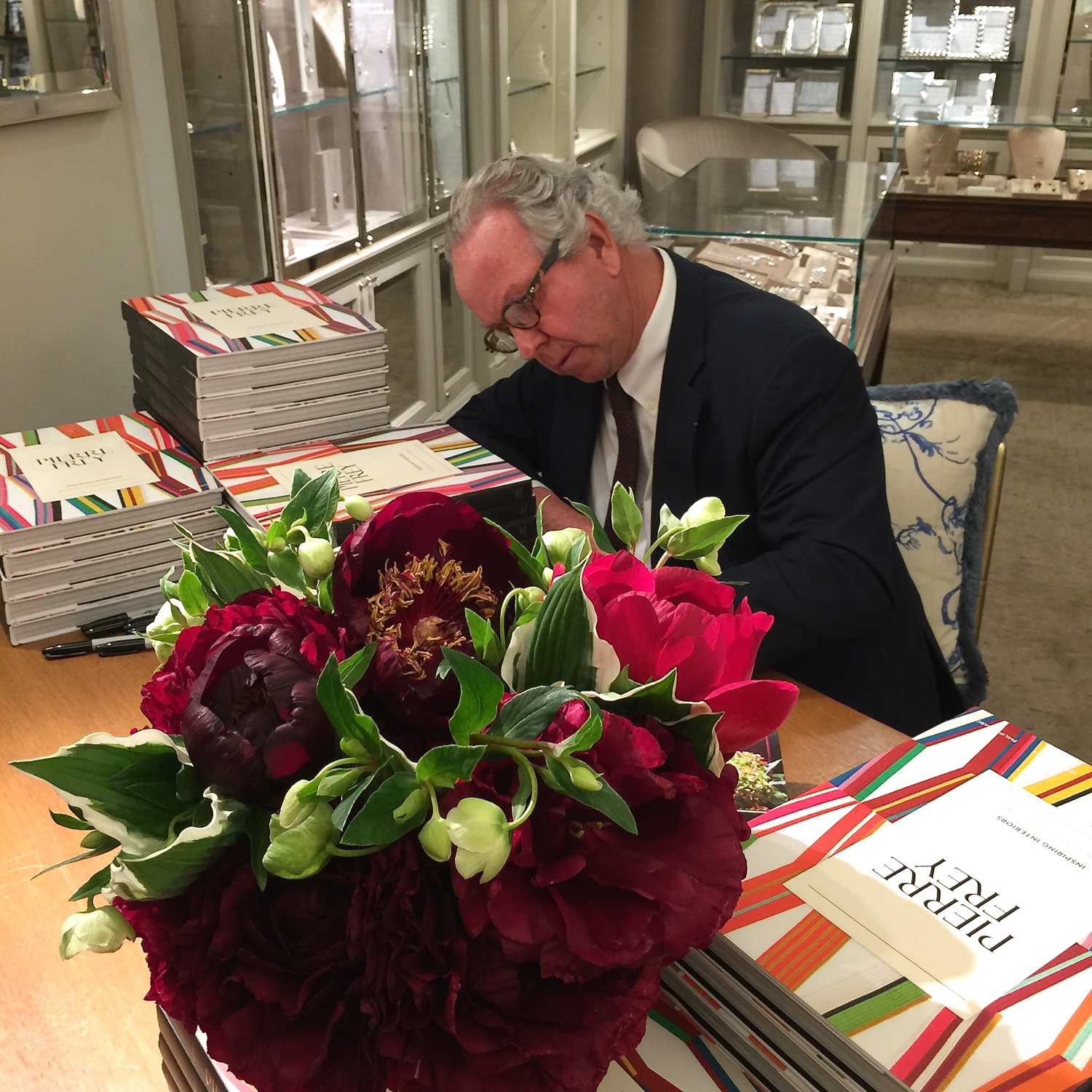LEFT // Bastideaux Awahnee Stripe in Aegean/Cement
RIGHT // ZAK + FOX Chimi in Sunica
BOTTOM // Kettlewell Collection Kimono in Charcoal
Pierre Frey Inspiring Interiors
An occupational hazard for those of us in the design field is we want all of the pretty things that are paraded in front us. When I was decorating, I handled this dilemma by choosing my favorites and bestowing them like like gifts to my clients. If I couldn't have them, they should.
Now that I spend my time writing about design, I need another solution.
A book like Pierre Frey Inspiring Interiors provides the perfect answer. All of my darlings from the House of Pierre Frey are gathered together in one volume, allowing me to pull it off the shelf and drink in the beauty whenever I need a shot of loveliness in my life.
The book is roughly divided into four parts, each of which is equally fascinating. It opens with a personal account of the history of the House of Pierre Frey. How fabulous that a business founded in the 1930's is still run by the family. The key players are all featured and sprinkled throughout the book are tantalizing glimpses of their homes, which naturally feature Pierre Frey products. I can assure you that the current head of the company, Patrick Frey, is very charming, having met him at a recent book signing at Bergdorf Goodman.
Next the book explores the stunning, historical Pierre Frey Museum. Can I move in? Their archives are astounding and richly illustrated.
You will gasp at images of fragments of men's waistcoats and pockets embroidered on silk from the 18th century.
This gorgeousness is followed up with features on some interior designers who use Pierre Frey and more luscious photographs featuring the fabric, wallpaper and other products, with descriptions of the inspiration behind them. Creative mood compositions that will get your juices flowing also are shown.
Finally, the book closes by showcasing the artisans behind the designs such as the weavers, embroiderers, embossers and upholsterers who bring it all to life. Experiencing the individual hands at work is moving and compelling.
This book is a must for any design library.
IMAGE CREDITS // Images in the collages are courtesy of the House of Pierre Frey and are from the book. All other photographs by Lynn Byrne of Decor Arts Now. Thank you to the House of Pierre Frey for providing a review copy of the book to Lynn.
EDITOR CREDIT // This post was developed and written by guest editor Lynn Byrne.
Babi Ahluwalia
what is your idea of perfect design happiness? TO ENVISION AN IDEA OR SOMETHING IN MY MIND AND THEN BE ABLE TO FIND THE RESOURCES TO EXECUTE IT. PERFECTION WOULD BE FINALLY SEEING THAT THE APPLICATION OF MY IDEA HAS EXCEEDED MY INITIAL VISION FROM ITS CONCEPTION.
what is your greatest fear in design? I HAVE NO FEAR IN DESIGN.
which historical design figure do you most identify with? MAHARAJA OF PATIALA. THE REGALITY OF HIS AURA, AND IN ESSENCE, ALL THE ROYALS FROM INDIA, IS AWE INSPIRING.
which living designer do you most admire? OSCAR DE LA RENTA BECAUSE OF HIS TIMELESS STYLES AND SUCCESSFUL LONGEVITY.
what profession other than design would you like to attempt? SOMETHING IN THE CREATIVE FIELD SUCH AS ADVERTISING OR CALLIGRAPHY.
what is your greatest design extravagance? MY PROCLIVITY TO TRAVEL AROUND THE GLOBE FOR INSPIRATION.
when and where were you happiest with your design? IT’S HARD TO PICK ONE MOMENT. AS LONG AS I AM DOING WHAT I LOVE MORNING, NOON, AND NIGHT, I WILL ALWAYS BE HAPPY.
what do you consider your greatest achievement in design? MY TWO STORES IN NEW YORK. ANKASA MADISON AND ANKASA SOHO.
if you died and came back as another designer or design object, who or what do you think it would be? A TOOL USED TO EXPRESS SOMEONE’S CREATIVITY - AN EASEL, OR BRUSH OR PENCIL.
what specific design related talent are you lacking that you would you most like to have? A DEEPER UNDERSTANDING OF THE FORM OF DESIGN WOULD HELP SHAPE MY OVERALL UNDERSTANDING OF WHAT IT MEANS TO BE A DESIGNER.
what is your most treasured design related possession? MY MOST TREASURED POSSESSIONS AREN’T TANGIBLE OBJECTS BUT RATHER TRAITS THAT I HOLD DEAR SUCH AS MY KEEN EYE AND MY ABILITY TO VISUALIZE THINGS.
what do you regard as the lowest depths of misery in design? KNOCK-OFFS.
what curse word do you most frequently use? BLEEP! BLEEP! BLEEP! (I KNOW HOW TO USE THE F--- WORD).
what is your favorite design related word? ANKASA IT! (USED AS A VERB).
what is your least favorite design related word? PRICING!
what turns you on in design? ALL THE MYSTERY THAT IS INVOLVED IN CREATING AND THE INFINITE POSSIBILITIES THAT LAY AHEAD.
what turns you off in design? NOTHING REALLY!
what is your motto in design? WHEN I’M WORKING WITH MY TEAM MY FAVORITE SAYING IS “KEEP IT RELEVANT".
//
IMAGE CREDITS | via Ankasa and Sachin + Babi. Oscar de la Renta photo via Zaid Hamid.
ABOUT PROUST ON DESIGN | Answered by our design icons, these must-ask questions come from a 19th century parlor game made popular by Marcel Proust, the French novelist, essayist & critic. Proust believed the direct questions and honest responses that they elicited revealed the true nature of the individual. For this column, we have put a design related spin on the traditional questions. While this method has been used by many journalists throughout the years, we were primarily inspired by The Proust Questionnaire, which appears monthly on the back page of one of our all time favorite magazines, Vanity Fair (also Krista’s alma mater). Read all of the previous Proust on Design questionnaires here.
Provenance: Toran
prov-e-nance \ˈpräv-nən(t)s, ˈprä-və-ˌnän(t)s\noun. the place of origin or earliest known history of something.
Guest edited by Jacqueline Wein, Tokyo Jinja IMAGE | Antique Toran via The Textile Museum of Canada
A number of years ago I spied a charming doorway textile at the home of a dear friend. Clearly Indian in origin, it was a rectangular banner with small fabric flaps hanging down and tiny mirrors embedded in the pattern. She told me it was a toran, a hand embroidered and embellished door hanging, traditionally made in Gujarat, on the coast of Northwestern India. My fascination with them grew and over the years I have continued to keep an eye out for them.
The word toran (or torana) itself originally referred to sacred gateways in Indian architecture, with roots in Buddhism and Hinduism, like this pair of 12th century sandstone ones in Vadnagar, Gujarat. It is easy to see the connection between the embroidery of the fabric hangings and the detailed stone carvings, as well as in their function to welcome both the gods and people. Decorative toran also play a role in holidays like Diwali and Holi or at weddings and celebrations as they are believed to be auspicious and lucky. The doorway blesses every person that walks under it, showering them with an abundance of love, prosperity, health and happiness. While the heavily embroidered ones tend to be regional to Gujarat, toran in other forms are popular throughout India. In the south, green mango tree leaves are threaded together and hung across the door. In Northern India, marigold flowers are strung together and used the same way. The small flaps that hang from the fabric versions are meant to represent dangling leaves and flowers.
IMAGES | Torana Arch via Vadnagar, An Ancient City & Marigold Garland via Mitai and Marigolds
Often times toran are used in spaces other than actual doors to represent a passageway. This welcoming example from Sibella Court's Nomad book beckons one to enter and cozy up for a restful nap.
IMAGE | via Nomad: A Global Approach to Interior Style by Sibella Court
The Kutch region of Gujarat is particularly well known for its embroidery techniques, with specific tribes and communities having their own particular style. Shisha, which is the Indian word for little glass or mirror, is the most distinctive technique in which small mirrors decorate the textile, being held in place by a framework of overlaid embroidery stitches. No glue is used and the mirror is not threaded through or attached in any other way. It was believed that the mirrors had the power to ward off evil spirits by trapping or confusing the evil eye. While many of the other decorative stitches, such as the chain stitch, are universal, shisha work is unique to the Indian subcontinent. It comes as no surprise to me that women are solely responsible for these creations and that motif and patterns are not copied or written down, but instead passed along orally.
IMAGE | Antique Kutch Embroidery Toran from NovaHaat.com
Base fabrics and threadwork include cotton and silk and pieces over 50 years old may also have beadwork in addition to shisha work. Motifs are varied, from very naturalistic animals to very stylized patterns and geometrics. Mismatched patchwork is also part of their charm. Museum collections have toran from the late 19th century, but most of the older pieces available on today's market are mid-20th century. Invariably, the vintage pieces have some damage - in my mind, patina - and there are also many newly made toran available as well, although the details and quality of the silks doesn't match that of the older pieces. The decorative possibilities, in particular for children's rooms, are obvious. They make charming valances or would be perfect fronting a bed canopy. Some toran are as long as 30 feet and I have seen them draping the edges of party tents as festive adornment.
IMAGE | Antique Kutch Rabari Banjara Toran via EthnicIndianArt
In modern-day interior decor, toran can be used in a quite literal context to embellish the threshold, as in this rituously joyful, over the top Indian themed space that was featured in Marie Claire Maison.
IMAGES | Bollywood Boudoir via Marie Claire Maison & Vintage Toran via IndianBeautifulArt.com
But they are also incredibly sweet when taken completely out of context and used in ways you might not expect like here, hanging over a kitchen nook in floral designer Nicolette Camille's Brooklyn apartment. This toran also defines and elevates what would normally be a rather simple kitchen.
IMAGE | Nicolette Camille's Brooklyn, NY home via Design*Sponge
Perhaps best of all is when toran are part of a truly global design aesthetic. In Maryam Montague's Marrakech master bedroom, featured in Elle Decor, this toran-like textile used as a window valence mixes happily with decorative items from many nations, including France, Mali, and Morocco.
IMAGE | Maryam Montague's Marrakech master bedroom via Elle Decor
Have you used a festive toran as decoration in your home, or do you have something else to share with us on this topic? If so, we'd love to hear all about it. Please leave a comment below or email us at info(at)clothandkind(dot)com.
ABOUT PROVENANCE | Provenance offers a scholarly nod to the history of iconic styles in textile & design and is guest edited by Jacqueline Wein of the blog Tokyo Jinja. Previous Provenance topics include: Kasuri & Kuba Cloth.























